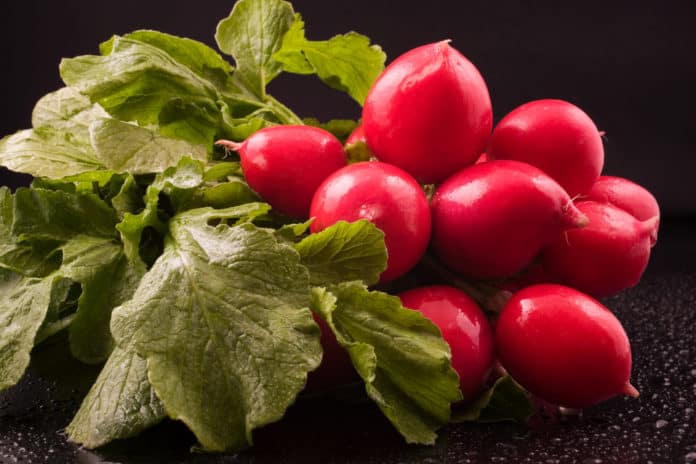As a member of the cruciferous vegetable family, the radish is a close cousin of veggie superstars broccoli and kale but boasts a long list of nutritional benefits unique to this red root. This lowly radish may seem like nothing more than an underused and unnecessary salad vegetable or a cute little red root to make into a rose-shaped garnish.
So what’s the buzz on radishes?
Radishes may not be the most popular vegetable in your garden, but they are one of the healthiest. These undervalued root vegetables are packed with nutrients. They may even help or prevent some health conditions. They’re loaded with fiber, vitamin C, folates, calcium, and phytochemical compounds that lower your risk of cancer.
Radishes are not well-studied for conventional medicinal use. Most studies have been done on animals, not on humans. Even so, radishes have been used as a folk remedy for centuries. They are used in Ayurveda and Traditional Chinese Medicine to treat many conditions such as fever, sore throat, bile disorders, and inflammation.
Radish may offer these additional health benefits.
Radishes are low in calories, and rich in folate, vitamins C, E, and K, and fiber. Eating a couple of servings each day helps you reach your daily fiber intake goal. Fiber helps prevent constipation by bulking up your stool to help waste move through your intestines. Fiber also may help you manage blood sugar levels, and has been linked to weight loss and lower cholesterol. Fiber is an important nutrient to incorporate if weight loss is the goal, as it helps keep you fuller longer.
Vitamin C is an antioxidant that helps battle free radicals in your body and helps prevent cell damage caused by aging, an unhealthy lifestyle, and environmental toxins. Vitamin C also plays a key role in collagen production, which supports healthy skin and blood vessels.
Radish also contains compounds that are broken down into isothiocyanates when combined with water. Isothiocyanates and indoles reduce activity that turns normal cells into cancer cells. Research has shown that they cause cancer cells to turn on themselves rather than on healthy cells. Eating radishes and other crucifers over the long term reduces your risk of several types of cancer including melanoma, colorectal, and others.
Cruciferous vegetables are also good sources of phytonutrients, which are plant-based compounds that may help lower inflammation and reduce the risk of developing cancer. Phytonutrients also boost the immune system so you’re less prone to infections and wounds heal more quickly.
Radish also helps to lower cholesterol levels in the blood and normalize blood sugar.
Radishes contain important enzymes and help regulate the production of bile and bilirubin. They are especially useful in detoxifying the liver and gallbladder by eliminating excess bilirubin. And as a natural diuretic, radishes aid in flushing the buildup of toxins in the kidneys which if left unchecked can lead to excess strain or infection.
Radishes contain sedative properties that have been known since ancient times. Both Greeks and Romans used radishes to promote sleep. Try a glass of radish, carrot, and ginger juice for a night snack that will help your body wind down and relax.

Delicious ways to use radishes
Radishes are often found sliced on top of salads, don’t limit yourself. Think outside the box!
- Steam or boil to soften them and sprinkle a hint of salt and pepper or garlic.
- Incorporate pureed radishes into mashed potatoes or cauliflower to boost nutrient levels.
- Dice raw radishes and incorporate them into salsas, dips, salads, and slaws.
- Thinly slice them and layer them on sandwiches or burgers for an added crunch.
- Add them to your fresh juice mixes
- Add thin radish slices to sandwiches.
- Make a radish dip by pulsing 1/2 cup of Greek yogurt, 1/4 cup chopped radishes, one minced garlic clove, and a splash of red wine vinegar in a food processor until smooth.
- Give tuna salad or chicken salad pep and crunch by adding 1 to 2 teaspoons of chopped radishes.
- Coarsely chopped radishes give tacos a zesty crunch.
- Use radishes as a healthy crudité for dips.
- Pickle them like you would cucumbers.
When preparing radishes, don’t toss the green parts. Radish greens are delicious and healthy. They are flavorful in salads or sautéed in a bit of olive oil and garlic. You can also mix them with other greens such as mustard greens, turnip greens, kale, and spinach.
Final Thoughts
Radish can be a great addition to almost any diet. Eat-in small amounts and you should be able to gain the wonderful benefits of radish nutrition while enjoying a spicy punch to almost any meal. Eating it may help you maintain healthy body weight and protect against chronic conditions, such as heart disease and certain cancers.



